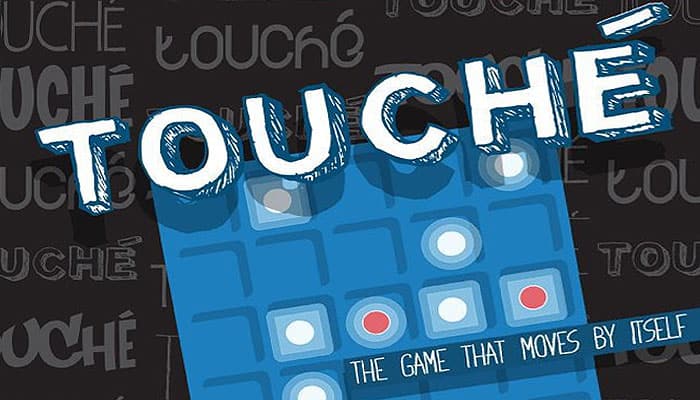

Components
- Game Board
- Pyramids in 4 colors
- Card-deck
- Rulebook
Object of the Game
To be the first player to line up four consecutive pawns of your color in a row-horizontally, vertically or diagonally. Pawns may be square or round, or any combination of shapes. You win by lining up colors, not shapes.
 Figure 1 |
Setup
-
Each player starts with six pawns of matching shape, round or square.
-
Inside each pawn is a disc, white on one side and red on the other. Round pawns always begin the game with the white side showing; square pawns always begin the game with the red side showing.
-
To set a disc to the correct starting color, place a pawn on its matching Shape and Color Indicator. Round pawns will always flip to white on the Round White Indicator. Square pawns will always flip to red on the Square Red Indicator.

-
When the pawns have been set to the correct starting color, they are placed in the reserve areas as shown in Figure 3.

Game Play
-
First Moves
White always goes first, placing any round pawn on any space in White's base row (the row closest to White's reserve area). Red then places any square pawn on any space in Red's base row.

-
Any pawn in the reserve area can enter anywhere on the base row. Pawns may also enter the board by jumping a pawn already on the base row, as shown here:

Yes!
Any of the pawns in the reserve area may enter the board by making a direct jump over the pawn in the base row to move into space A, B, or C.
No!
Pawns in the Reserve area may not jump into the spaces marked "X" because they cannot make direct jumps over the pawn in the base row.
-
After the First Move
After the first move, plays may chose to enter a new pawn or move any pawn already entered, regardless of round or square shape, or color showing. The one exception-you may not move the pawn last played (see rule 7).
-
The Hidden Force
Hidden beneath the board is a magnetic force. The force can flip the disc inside a pawn to the opponent's color, allow it to remain the same, or flip a color from the opponent's to your color.
-
The Key to the Game

Players must remember: Whenever a round pawn is white on a given space, a square pawn (on the very same space) will always be red. And vice versa. Try this no several different spaces on your board.
This will always be true; remembering this effect during the course of the game is the key to the game.
-
At the beginning of each game, players will not know the effects of the different spaces on the round or square pawns.
As play progresses, however, each player will learn the effect of each space (for each different game) as pawns are moved. Players must try to remember these effects to build their strategies.
-
Which Pawns May Be Moved Once entered on the board, any pawn may be moved by either player-no matter what shape or color. The exception: a player may not move the last pawn played by the opponent. Remember, the object of the game is to get four discs of your color in a row-not four of the same shaped pawns.
Note: Since Any pawn can be any color, any pawn can help win!
How Pawns Move and Jump
-
A pawn may be moved, one space at a time, in any direction: horizontally, vertically or diagonally.
Strategy Note:
When first learning the game, try to set up opportunities for yourself by establishing as many rows of two's and three's as you can (in various directions).
As you become expert in the game you will, of course, adopt your own strategies which may vary from this approach.
-
A pawn can also jump over another pawn in any direction, or ...
-
A pawn may also make multiple jumps (similar to checkers-over one pawn at a time). However, before a pawn begins a multiple jump, the player must announce where it will finally end up.
A pawn making a multiple jump must always land firmly and pause on each in-between space to give both the player and the opponent the opportunity of seeing the color reaction on those spaces.
-
Pawn "A" will make a 3-way multiple jump, announced to end on Space 3. It jumps over pawn to Space 1, lands and pauses; jumps over pawn to Space 2, lands and pauses; jumps over pawn to Space 3 and lands, thus completing the 3-way multiple jump.

Figure 2
Preparing for the Next Game
Strategy Note:
Look for and make multiple jumps in order to learn the reactions of as many spaces as possible.
If, for example, you had made the move in Figure 2, you would know whether you needed a round or a square pawn to achieve your color in Spaces 1 and 2.
A Move Is Final
Once a pawn is played, the play may not change the move. A multiple jump move must be played out to its announced end.
End of the Game
Line up four consecutive pawns (square and/or round) containing your color, in any direction-and win. Touche!
Red is the winner of this sample game.

Re-set the pawns using the Shape and Color Indicators, and place them back in the reserve area.
After each game, lift the removable blue playing grid, using the two finger indentations, and take out the 5 two-sided magnetic strips.
Shuffle them and randomly reposition them. They can be replaced either horizontally or vertically.
The result is 245,760 different board combinations to challenge you-and your opponent-in the next exciting game!
Continue Reading

